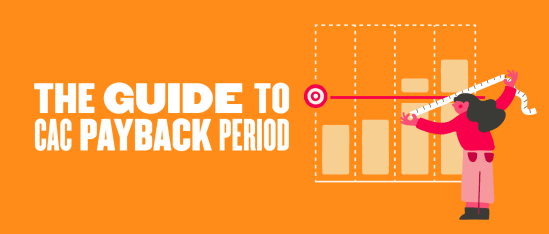What is CAC payback period?
CAC payback period measures how long it takes to recover the money spent on acquiring a customer. It’s a key metric for understanding how efficiently your company turns investment into revenue—and how quickly you can reinvest to support growth.
The calculation includes acquisition-related expenses like marketing campaigns (SEO, PR, social media), as well as operational costs such as sales and marketing team salaries. Ideally, your CAC payback period should be shorter than your customer lifetime value (LTV). If it’s not, it may mean your acquisition costs are too high relative to the value those customers bring over time.
<< Download the SaaS metrics cheat sheet. >>
Beyond running out of cash, one of the biggest concerns for CFOs is presenting inaccurate numbers to board members or potential investors. And that risk often starts with how key metrics—like those that reflect company growth—are calculated and interpreted.
Finance expert Ben Murray, founder of The SaaS CFO, has emphasized this point. On an episode of The Role Forward podcast, he noted that while many metrics have standard formulas, teams often modify them—sometimes leading to inconsistent or misleading results. His recommendation: build a clear customer acquisition cost (CAC) profile that incorporates multiple sales and marketing efficiency metrics to understand what’s really working.
CAC payback period is a perfect example. It’s one of the most important metrics for SaaS companies—and also one of the easiest to miscalculate or misrepresent without a consistent, transparent approach.
How to calculate CAC payback period
While the CAC payback formula may evolve as a company grows, the goal stays the same: use CAC payback period to establish a baseline for profitability and forecast consistent, sustainable revenue.
Because CAC payback is driven by your customer acquisition cost, you’ll need to start there. CAC includes all the expenses tied to bringing a customer from first touch to signed contract. That means factoring in sales-related costs like commissions and salaries, along with marketing spend and the marketing team’s compensation.
Once you’ve calculated CAC, you can determine your CAC payback period. The formula is simple:
- CAC ÷ (net new monthly recurring revenue – average cost to serve)
You can also use annual recurring revenue (ARR) instead of MRR, depending on what fits your model. The difference in the denominator—net new revenue minus cost of service—is often referred to as your gross margin, and it helps indicate how much revenue is actually contributing to recovering acquisition costs.
As Ben Murray noted, the way you calculate CAC can shift as your company grows. In the early stages, you might assume that 100 percent of your sales and marketing spend goes toward acquiring new customers. But over time, as you define different ideal customer profiles (ICPs), it makes sense to calculate CAC by segment.
One approach is to analyze CAC on both a logo basis (per customer) and a dollar basis (per revenue amount). This helps you understand CAC payback periods across different segments—like small and mid-sized businesses versus enterprise clients. You can also use cohort analysis to track how CAC trends over time and identify areas for improvement.
Why break CAC down this way? It gives you a clearer, more nuanced view of what’s driving acquisition costs. That leads to a more accurate, reliable CAC payback period—and better decisions as a result.
Advantages and disadvantages of CAC payback
As with most things, there are tradeoffs, let’s examine some of the pros and cons of calculating CAC payback for SaaS companies.
Advantages of CAC payback
CAC payback is a critical metric for SaaS companies—it not only helps forecast when you’ll recoup customer acquisition costs, but also reveals how efficiently your business is turning investment into revenue.
Think of CAC as a form of debt: it’s an upfront investment in acquiring a customer, and that investment needs to be earned back over time. If a customer churns before the payback period ends, that “debt” still exists. Poor retention only increases this burden, putting pressure on new customer acquisition to cover the gap.
This has a direct impact on working capital and highlights the trade-offs between investing in acquisition versus other priorities, like product development or headcount planning.
Your CAC payback period tells you when acquisition costs return to the business—empowering sales and marketing teams to adjust spend, sharpen targeting, and improve overall efficiency. It also gives company leadership a key data point to share with investors and board members: clear visibility into when customers become profitable, and how future revenue can be reinvested to drive sustainable growth.
<<Tell the right story behind the numbers with this financial waterfall template bundle.>>
Disadvantages of CAC payback
CAC payback is often misunderstood—partly because many companies don’t calculate customer acquisition cost (CAC) in a fully burdened way. It’s also easy to overlook related factors like churn and retention, which aren’t directly built into the metric but still affect the bigger picture.
A fully burdened CAC includes more than just sales and marketing headcount. For example, if your CEO joins sales calls or supports customer success efforts, their time should be factored into the equation. Similarly, gross margin assumptions should reflect real costs—especially those tied to customer success—because they directly affect your CAC payback period.
There may be times when it makes sense to adapt the CAC payback formula to better fit your business model. As Ben Murray points out, traditional formulas are helpful, but tweaking them can add value—as long as the rationale is clear and shared across teams. The key is to ask: How are we managing the business, and what data will help us most?
Take sales rep ramp as an example. While rep salaries are part of CAC, the fact that new hires won’t be fully productive for months can skew your payback calculation. One approach is to run both versions—CAC with and without ramping—so you get a clearer view of overall efficiency within your go-to-market strategy.
What is the difference between the CAC payback period and the LTV/CAC ratio?
While CAC payback period tells you how long it takes to recover your acquisition costs, the LTV:CAC ratio measures the value a customer delivers over their lifetime compared to what it cost to acquire them.
This ratio is particularly sensitive to churn. If a customer leaves early, their lifetime value drops—bringing the ratio down with it. (That’s one of the key differences between LTV:CAC and CAC payback: churn isn’t baked into the payback calculation.)
LTV:CAC can vary widely, especially when customers sign on at different contract values. In cases like this, it can be helpful to look at both the median and the maximum to get a sense of the range.
For SaaS companies, a healthy LTV:CAC ratio is typically around 3:1. If it’s lower, it might be time to reassess your acquisition strategy. If it’s on target or higher, it’s often a green light to keep investing in growth.
LTV:CAC is especially useful for early-stage startups investing heavily in customer acquisition. At later stages, it remains important—but combining it with CAC payback period adds depth by showing how quickly your investment is recovered, helping set realistic growth benchmarks.
CAC payback period benchmarks
Benchmarks for CAC payback vary by industry, but for SaaS companies, a strong target is typically 12 months or less. Some aim even lower—closer to 5–7 months—depending on their model and growth stage.
Retention metrics like logo retention and net revenue retention are also essential when evaluating CAC payback benchmarks. If your customer retention is high, you may be able to support a slightly longer payback period. The more segmented your CAC payback analysis, the more effectively you can assess your go-to-market strategy and make informed decisions.
At its core, CAC payback is a forward-looking metric. It helps you protect your runway, improve operational efficiency, and scale sustainably. Regularly revisiting this metric ensures you’re using funds wisely and building a business that’s both profitable and resilient.
Four actionable ways to reduce your SaaS company’s CAC payback period
Customers may come in at varying contract sizes and terms, but the faster they become profitable, the sooner you can reinvest that revenue to drive growth. Shortening your CAC payback period starts with alignment—between finance, sales, and marketing—and focusing on the two levers you can control: retention and acquisition cost. These four strategies can help optimize both.
1. Cut average cost of service
Your average cost of service includes everything from customer support and software hosting to the account managers and customer success teams supporting customers post-sale.
If this cost feels high, start by digging into your historical data. Tools like accounts payable aging reports can uncover opportunities to renegotiate vendor contracts. You can also partner with your customer success leader to review CS team performance—are there patterns showing uneven productivity? Identifying and addressing these gaps can make your service delivery more efficient without sacrificing customer experience.
2. Update your SaaS pricing strategy
If your CAC payback period is stretching too long, it may be time to ask: Does your pricing reflect the value you’re delivering?
Updating your pricing strategy can help shorten the path to profitability. Consider whether a price increase is warranted, or if changes to payment structure—like shifting from monthly subscriptions to annual contracts or exploring usage-based pricing—could accelerate cash inflows and improve payback.
3. Collaborate with sales & marketing to bring campaign costs down
Finance uncovers the “why” behind the numbers by working closely with sales and marketing—and asking the right questions. What if you replaced paid ads with a referral campaign? Are your teams aligned on ideal customer profiles (ICPs) and product–market fit? Are marketing and sales efforts focused on the right prospects?
These conversations can prompt sales and marketing to revisit the customer journey and look for ways to strengthen the funnel. That might mean promoting high-performing blog content, expanding your knowledge base, or sharing educational resources more intentionally throughout the sales process—all of which can help attract and convert better-fit customers, faster.
4. Upsell and cross-sell to existing customers
Upselling and cross-selling can help accelerate CAC payback—especially when timed right. If a customer sees value early and becomes an advocate for your product, they’re more likely to explore additional features or services.
While these expansions don’t offset churn or substitute for breakeven CAC recovery, they can help fill in revenue gaps and offer insight into the customer’s growth journey. Strategically timed upsells not only boost revenue but also reinforce long-term retention and customer satisfaction.
CAC payback FAQs
What is a good CAC payback period?
A strong CAC payback period for SaaS companies typically falls within 12 months—or even shorter, with some aiming for 5–7 months. If your customer retention is high, you may be able to support a longer payback window. Ultimately, though, the right benchmark depends on your industry, customer base, and go-to-market strategy.
Recommended For Further Reading
Does CAC include salaries?
Salaries factor into both cost of sales and cost of marketing—two key inputs in your CAC calculation. That includes sales team salaries and commissions on one side, and marketing team compensation and ad spend on the other.
What is the CAC payback formula?
The CAC Payback formula is as follows:
- CAC payback period = Customer acquisition cost / revenue – average cost of service
This calculation measures how long it takes to recover the cost of acquiring a new customer—using the gross margin generated by that customer as the basis.


